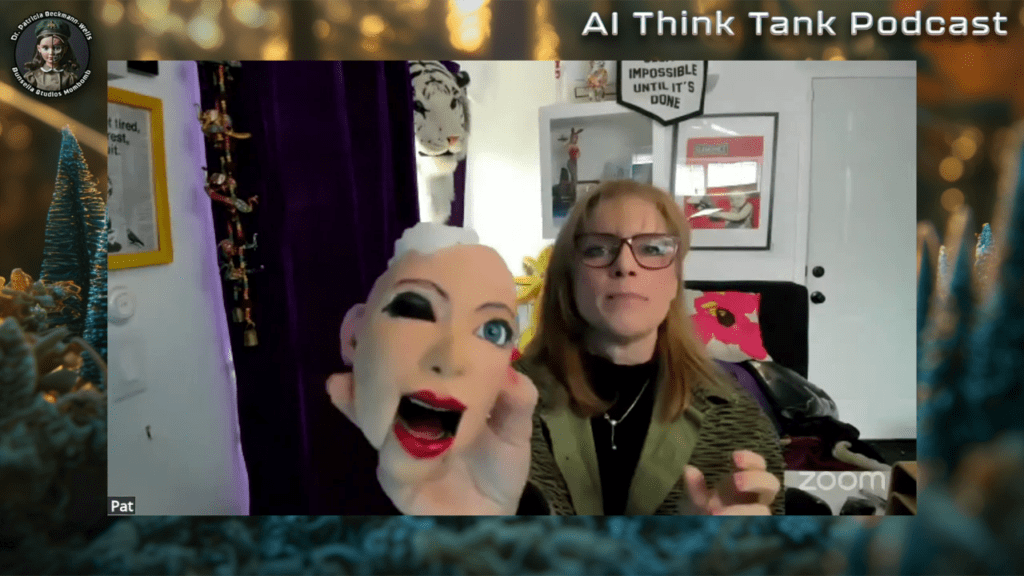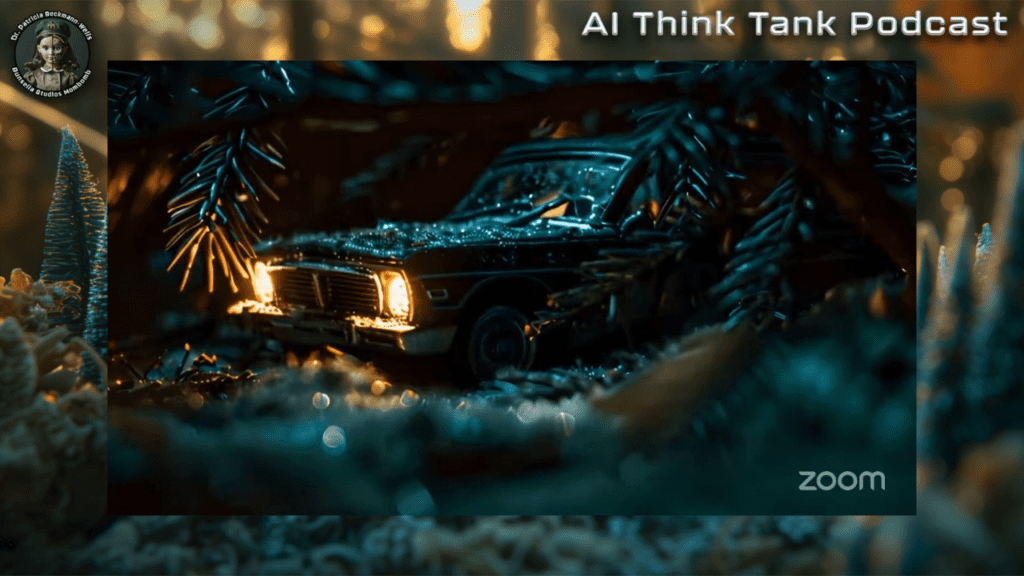Interview with Dr. Patricia Beckmann-Wells

The latest episode of the AI Think Tank Podcast was one for the books. I had the incredible opportunity to sit down with a true pioneer in animation and AI-driven filmmaking, Dr. Patricia Beckmann-Wells. A veteran of DreamWorks and Disney and now the creative force behind Buncella Films, Patricia joined me to explore the cutting edge of AI in cinema and her latest passion project: Mom Bomb, a feminist comedy horror born from over a dozen AI tools. Buckle up, we covered everything from forensic skull modeling to puppet-driven marionettes powered by Arduino. This episode was a fun look into how human creativity merges with the machine.
A mosaic of experience
From leading animation pipelines at major studios to shaping global production teams, Patricia’s journey into filmmaking is a beautiful tapestry. As she told me early in the episode:
“You have to live this guerrilla life when you join the film industry. It’s never a straight path. It’s a mosaic.”

Her path began far from Hollywood. She worked as a journalist, co-authored works on foreign policy, and even did a stint at NBC Radio and the White House before leaping headfirst into the USC Cinema MFA program. That moment of taking a chance led to long-lasting industry relationships and, eventually, groundbreaking work in cinematic AI.
The science of representation: Face It
One of Patricia’s most acclaimed contributions to the visual arts and digital identity design is her book Face It, A visual reference for multi-ethnic facial modeling. It started during her doctoral studies at USC when she noticed a stark gap in digital representation.
“We partnered with forensic researchers at Bone Clones. They helped us analyze how the clines of the world shaped skull structures, and how subtle genetic markers impacted facial characteristics across regions.”
Patricia approached this with rigor, precision, and empathy. The book was quietly published but gained traction fast, eventually being adopted by animation and gaming giants like Pixar, DreamWorks, and Epic Games. Her insights even helped fuel the MetaHuman project at Epic, a fact she’s both humbled and proud of:
“Epic said the MetaHuman project was largely based on the book. I still can’t believe it.”
And that’s not all. Face It is getting a new chapter. Chapter six, set to release soon, will explore how fat deposits move during aging, addressing deeper visual authenticity in digital humans.
AI as a sculptor’s tool
What fascinated me most was Patricia’s hands-on approach to blending traditional artistry with AI. When we explored her concept art and video clips from Mom Bomb, I was floored by the realism of her AI scenes:
“This could be a real neighborhood,” I said while looking at one of her generated shots.
“It’s mostly words,” she replied with a smile. “But I do a lot of sculpting that drives the look. The influence is real.”
From Mr. Rogers-style set designs to cinematic tilt-shift photography mimicked through prompt engineering, Patricia’s AI visuals evoke something deeply nostalgic and deeply human.
She revealed the tools behind the curtain, too: MidJourney for still images, Unreal Engine’s MetaHuman with Live Link for performance capture, Meshy for generating 3D models from text prompts, and Runway for animating expressions.
“The beauty of this filmmaking is that you can do anything,” Patricia noted. “But the story has to run the production, not the AI.”

Mom Bomb: A feminist horror built with AI
Mom Bomb isn’t just a tech experiment, it’s an emotionally rich story rooted in trauma, survival, and generational memory. One particularly intense scene she shared involved a girl recounting a harrowing moment during World War II, voiced by Patricia herself but transformed by AI.
“That was actually one of my father’s stories,” she told me. “What you’re seeing are metahumans animated in Unreal with facial expressions created live. The AI changed my voice to match the character.”
What stood out to me was her love for AI “hallucinations” and the moments when generative tools go off-script and produce surreal, unexpected visuals.
“That’s the best part of AI,” Patricia said. “The hallucinations. It’s what it’s made to do. And I hope that doesn’t get bred out.”
Throughout the episode, we watched clips, design breakdowns, and behind-the-scenes footage. The Mom Bomb universe includes squirrels as spirit guides, war flashbacks, dream sequences, and therapy dolls created in Meshy and animated in Runway. All of it was produced, remarkably, in a fraction of the time of traditional animation.

From puppetry to pixels
What makes Patricia unique isn’t just her use of AI, it’s how she brings 1970s-style DIY filmmaking into the modern era. She hand-sculpts characters, builds wigs from goat hair, prints puppets using a clay 3D printer, and once planned to animate Mom Bomb entirely with marionettes powered by Arduino.
“I was even thinking of replacement heads for stop-motion scenes,” she shared while holding up an eerily lifelike puppet head on camera. “Then AI suddenly became viable. So I pivoted.”
Her sculpting knowledge now informs how she prompts AI. These are not “AI films” as much as they are films made with AI. There’s a difference.
Real stories, real stakes
The emotional core of Mom Bomb is heartbreakingly real. Patricia opened up about a personal trauma that inspired her to write the story, an encounter in her childhood with two men who later became infamous serial killers. She didn’t learn the full truth until she was 28.
“I didn’t even know this. My parents didn’t believe me. They thought I was just reacting to their stories of the war.”
It’s through AI storytelling that she finally began processing that past and visualizing it.
“I sculpted that story out of AI. And now it’s evolving into a larger story about healing and facing generational trauma.”
Her long-term vision? To create a stop-motion feature film that merges AI-assisted in-betweening with traditional puppet design, something that can retain that “organic look” while shortening the production timeline.

Collaborators wanted
Patricia is currently looking for studio partners to take Mom Bomb to the next level.
“I have the feature-length script. I’m visualizing the entire thing in AI. I’d love to collaborate with an AI development team or a major studio. The story is so important right now.”
She’s already 75% through Part 3, and if things keep moving, the full film could be finished conceptually by the end of summer.
To all developers and creative studios out there: this is your chance to partner with a visionary who has deep industry experience and a strong artistic compass.

Final thoughts
AI in cinema is not about replacing filmmakers. It’s about equipping them with tools to tell stories that might otherwise never get made. Patricia Beckmann-Wells exemplifies this better than anyone I’ve met. Her commitment to handcrafting the story, whether it’s with sculpting clay or sculpting prompts, is unmatched.
“Your story can run the production,” she said, “instead of AI.”
This episode reminded me why I started this show: to find people like Patricia, people who aren’t afraid to blend bleeding-edge tech with the most human of instincts: storytelling.
You can find more of her work and reach out to collaborate through her website www.MomBombFilm.com or on Instagram at @MomBombFilm.
Join us as we continue to explore the cutting edge of AI and data science with leading experts in the field. Subscribe to the AI Think Tank Podcast on YouTube. Would you like to join the show as a live attendee and interact with guests? Contact Us

